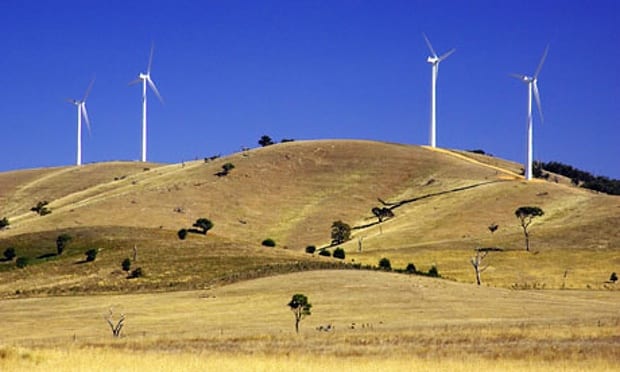Just weeks after the federal government ordered the Clean Energy Finance Corporation to cease backing wind energy development in Australia, Victoria’s state Labor government has committed to use its purchasing power to drive new investment in wind farms, as part of its broader renewables policy, released on Friday.
The Andrews government’s proposed green energy contracts would initially be used to kick-start work on the construction of 100MW of new wind turbines in the next six months – just a fraction of the estimated 2,489MW of wind farms with planning approval estimated to be the pipeline for Victoria.

The announcement – part of the Labor’s Renewable Energy Roadmap policy, which has set a baseline renewable energy target for Victoria of 20 per cent by 2020 and has also promised to address the increasingly contentious issue of network discrimination against rooftop solar households – is a big deal for an industry that has suffered for more than 18 months under both prohibitive state planning laws, and under a federal government that has an active dislike of wind farms.
Just over a year ago, Victoria was notable as the state in Australia with the most prohibitive wind farm planning laws, introduced under the conservative leadership of former Liberal Premier, Ted Baillieu.
The restrictions, which effectively crippled development, included a right of veto for households living within 2km of proposed wind turbines; the creation of ‘no-go’ zones in key areas like the Great Ocean Road, the Yarra Ranges, and the Mornington Peninsula; the creation of exclusion zones around 21 Victorian towns; as well as another rule – the only one to be amended by Baillieu’s successor, Denis Napthine – making it harder for established wind farms to make changes or extend already approved plans.
Flash forward a year, and the Labor Andrews government has committed to a Victorian Renewable Energy Target, and to generating investment and jobs. And it has done so in Portland, the home of Australia’s biggest wind tower manufacturers, Keppel Price, and part of Napthine’s former electorate.
The Roadmap – which the government says it developed in partnership with energy industry representatives, consumer groups and environment groups – identifies four priority areas, including the VRET, boosting renewable energy investment, addressing barriers to the take-up of rooftop solar (and grid discrimination to existing solar customers), and supporting clean energy jobs through the $20 million New Energy Jobs Fund.
In a Foreward to the policy document, state energy minister Lily D’Ambrosio says the Roadmap will also help identify policy and regulatory
barriers which are stifling renewable energy development at a state level and investigate options for Victoria to take action where federal policy is failing, to attract clean energy investment and jobs for Victoria.
“Victoria has recognised that there is plenty of scope to go above and beyond the national target and build a smarter, cleaner, more modern economy,” said Clean Energy Council policy manager Alicia Webb.
“For a state whose economy is so heavily reliant on brown coal to set a renewable energy target of at least 20 per cent by the end of the decade is very ambitious, and the government should be congratulated for showing such strong national leadership.”
But, for an industry that has been through the policy wringer, local reaction to the announcement today is somewhat tempered.
“(This) is a good first step,” said Environment Victoria’s Mark Wakeham, adding that it would kick-start work on new wind farm construction and generating new jobs and investment in regional Victoria.
Wakeham said a state renewable energy target was also welcome, but added that it would be important that had its own policy mechanism, such as the ACT government’s reverse auctions.
“We will be urging the Andrews Government to set a date for decarbonising the Victorian economy and then setting its renewable energy targets to follow suit.
“The sooner we move to pollution-free energy the better for Victorians, both in terms of the environment but also through reaping the jobs and investment benefits of being a clean energy front-runner,” Wakeham said.
Friends of the Earth’s renewable energy spokesman, Leigh Ewbank, also described the policy announcement as “a positive first step.”
“It will see more wind farms built across the state, driving investment in farming and regional communities, and creating manufacturing jobs in places such as Portland,” he said.
And Ewbank is optimistic that the baseline VRET of 20 per cent by 2020 will soon be ramped up.
“There are enough approved wind farms in the state for the Andrews government to smash the baseline target of 20 per cent by 2020,” said Leigh Ewbank.
“Building the shovel-ready wind farms alone would put us at around 26 percent renewable. And that’s not accounting for the rooftop solar revolution that’s underway.”
The ACT has a renewable energy target of 90 per cent by 2020; South Australia 50 per cent by 2025; and Queensland, 50 percent by 2030. Federally, the Labor opposition has committed to a national goal of 50 per cent by 2030.
“A Victorian target that matches the ambition of the ACT or South Australia would be welcomed by the community. And it would ensure Victoria is not out-competed by other states.”










